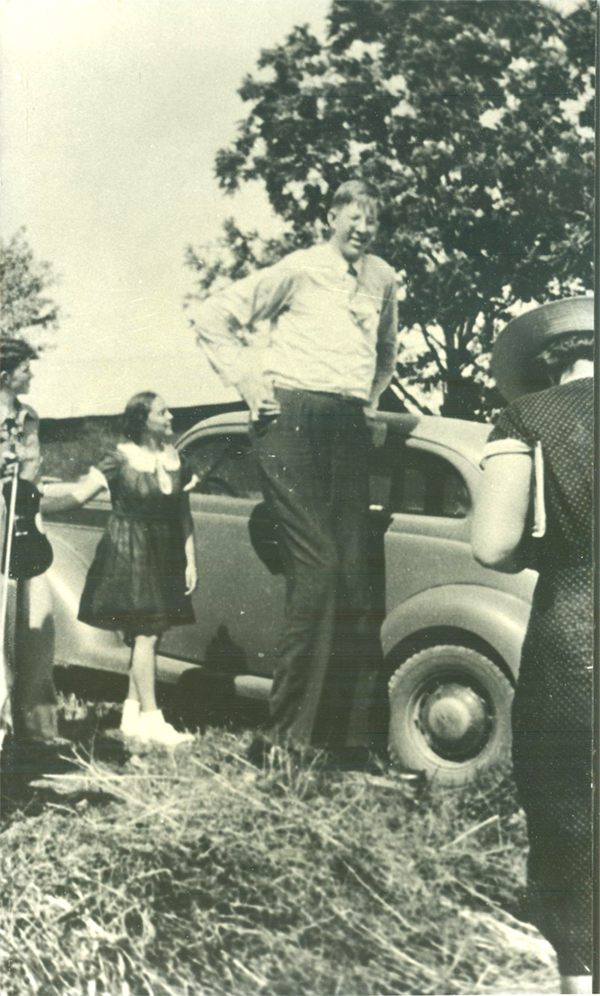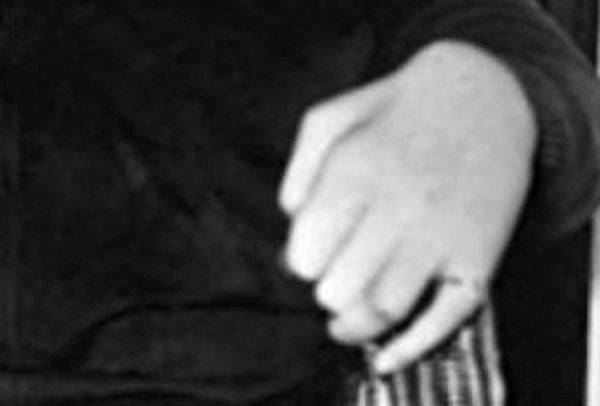The Tallest Freemason of All Time Owned The World’s Largest Secret Ring

Robert Wadlow at a family picnic at Roodhouse circa 1939. (Photo: Alton Museum of History & Art)
This story was sponsored by the fine folks of Enjoy Illinois.
Robert Wadlow was born in 1918 as an unremarkably sized baby and died 22 years later, in 1940, as the world’s tallest man. He was 8 feet 11.1 inches when he died. To this day, no one has been known to grow taller.
As a kid, Wadlow could simply wear adult clothes, but as he kept growing, conveniences designed for people of average height no longer served his needs. And of all the practical problems that confronted Wadlow during his life, the ones that attracted the most attention involved his hands and his feet.
Living in western Illinois, not far up the river from St. Louis, Wadlow had reached 6 feet tall by the time he was eight years old. As a teenager, heading towards 8 feet tall, he had to duck his head through doorways. At a restaurant, he had to stretch his legs straight through to the other side of the table. By the time he was an adult, he needed a bed specially made to fit his whole body, and a giant chair to keep him comfortable.

A St. Louis event promo. (Photo: Alton Museum of History & Art)
But shoes were a particular challenge for Wadlow. He quickly outgrew the normal size chart, and newspaper reporters were fascinated both by the size of his shoes and their cost. In 1928, he wore triple E size 21 shoes that cost $30 a pair, the United Press reported. In 1931, a health columnist reported that his size 25 shoes cost $50. In 1933, he was up to size 31, at $84 a pair.
By 1936, a shoe company had signed him up as a spokesperson in exchange for keeping him in footwear: each pair of shoes, the company told the Milwaukee Sentinel, cost $200 to make, because the leather needed to be reinforced with metal.
Part of the fascination with these shoes was their incredible cost. In 1936, smack in the middle of the Great Depression, $200 was an incredible amount, about the equivalent of $3,500 today, to spend on shoes. But the shoes themselves were treated as a spectacle, too. When Wadlow traveled across the country to promote his shoe sponsor, he would sometimes leave pairs behind for people to gawk at.

One of Wadlow’s very, very large shoes (Photo: Doug Coldwell/Wikimedia CC-BY-SA 3.0)
As a consequence, those shoes are some of the few of Wadlow’s possessions that are still around. When he died, of an infection that started in his leg, his family took care that neither his body nor his stuff would be paraded around as curiosities. They burned most of his possessions and buried him in a huge casket, sealed in a concrete vault. Since the world’s previous tallest man had arranged with his friends to sink his body into the sea, only to have it sold to an enterprising scientist for 500 British pounds, this was not an unreasonable precaution.
Wadlow’s mother, in particular, “was really reluctant to make a spectacle of him,” says Brian Combs, a board member of the Alton Museum of History and Art, which today has the world’s largest collection of Wadlow memorabilia. The museum aims to respect that desire, by “displaying what items we have in our museum with pride and dignity,” as the collection’s website puts it.
There are some oddities in the museum (a 14 foot gourd with Wadlow’s face painted on it, a cast of his jaw), but also some of Wadlow’s possessions: eight pairs of shoes, his graduation gown, his guitar case, tennis racquet and camera.
If Wadlow’s shoes attracted attention during his life, more recently, it is an ornament he wore on his finger that has become the object of fascination. To understand how big his hands were, consider this. His camera was a normal-sized camera, and the Milwaukee Sentinel reported that he used to take pictures secretly, by concealing the camera in his hand and letting the lens sneak between his giant thumb and forefinger.

From a photo taken in 1939: Wadlow’s hand (Original photo: The Telegraph)
In 1939, not long before he died, Wadlow joined the local Freemason lodge and was made a masonic ring. It’s widely reported that this was the largest Freemason ring ever made.
That’s “very likely true,” says Combs. “As far as I know it is.”
At the very least, it was a very large Freemason ring—size 25. The museum has a replica, made by the same shop as the original. “We like to illustrate it with a silver piece—with a half dollar in the middle,” says Combs.





Follow us on Twitter to get the latest on the world's hidden wonders.
Like us on Facebook to get the latest on the world's hidden wonders.
Follow us on Twitter Like us on Facebook